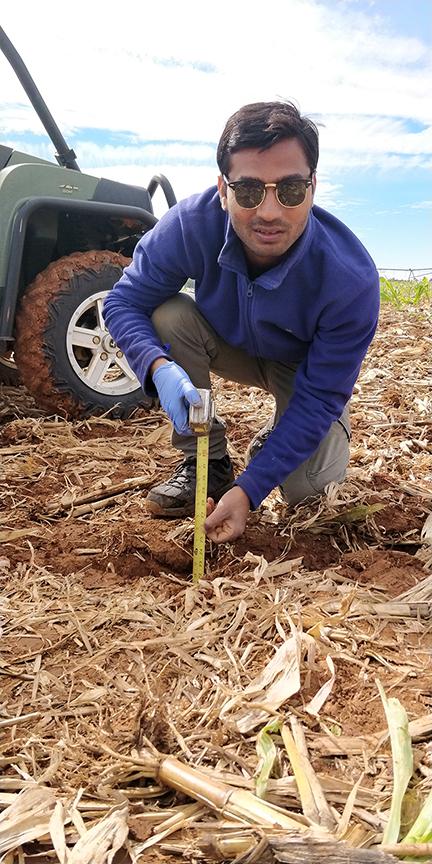Determining when or how much to irrigate a farm field is currently more guesswork than scientific process. With more than 70% of the global freshwater supply used in agricultural irrigation, University of Maryland Extension (UME) faculty member Dr. Hemendra Kumar is working to make the process more science -based to help farmers reclaim the energy, resources, and money associated with inefficiently irrigating crops.
To support producers in improving and optimizing their irrigation efficiency across Maryland, Kumar, the UME Precision Agriculture Specialist, received a $1.4M grant from the USDA Natural Resources Conservation Service (USDA-NRCS) to develop comprehensive data for the site-specific Irrigation Water Management plans and a new guidebook to supplement to national guidelines.
“What I’m trying to do is climate- and water-smart irrigation management,” said Kumar. “With my engineering background, I look for solutions, how I can solve a problem, and we need to either optimize the systems that we have or find an alternative.”
Currently, the most advanced irrigation systems in the country are the center pivot system – prevalent on the Eastern Shore in Maryland – where large sprayers mounted on metal structures designed to cover multiple acres by rotating around a central point can pump thousands of gallons of water, and cost thousands of dollars to install, operate and manage. The technology is suitable, but the application strategies tend to be uniform, with a sprayer pushing the same amount of water over a field regardless of the plant’s optimal needs.
However, when a farmer chooses to irrigate is not a science-based process, says Kumar, with many testing soil moisture by looking for visible plant distress like browning or withering leaves, or by grabbing a handful of soil from their field to see how dry it feels to the touch. Others may even simply see their neighbor irrigating and follow suit.

“That's something we want to change. We want Maryland farmers to use more science-based methods than the feel of the soil and visible stress in the crop,” he said. “We install sensors in different parts of the field so that we can see how the field is behaving, see the changes from one part of the field to another part of the field, like soil variation and crop yield. So if you are seeing fluctuations in soil moisture, soil water retention properties, and crop yield from one part of the field to another part of the field – or losing yield – that’s where you want to make decisions about your irrigation strategy.”
To inform the supplemental guidelines, Kumar will employ advanced modelling methods to extrapolate data from those soil sensors in fields across the state, coupled with information from weather stations which provide a wealth of input regarding precipitation, humidity, and other climate factors, and crop information like water requirements and row spacing for various plants.
Kumar and his team at the Precision Agriculture Lab (PAL) at UMD will work with Extension agents in the counties over the next three years to collect data on farm field and crop variations. The three year timeline will allow the team to account for shifts in weather and changes in precipitation variables from year to year, as well as determine how water is stored in the different soil types, how it’s released to the atmosphere through evapotranspiration rates, and how much is available to the plant itself.
The synthesized data will then be used to create the Maryland supplemental guide and shared with the NRCS to advise farmers seeking technical and financial assistance more specific than the national guidelines. It will also be used to help develop Irrigation Water Management plans for crop producers, which will help them save money while complying with water conservation standards.
“We need to take a holistic approach. We need to understand the importance of soil-water-plant-atmosphere continuum, explaining that effective irrigation depends on optimizing water use by accounting for the interactions between soil, plants, and atmosphere,” said Kumar. “It is essential to assess crop water demand accurately and provide irrigation based on their specific requirements, rather than solely relying on the available water supply.”